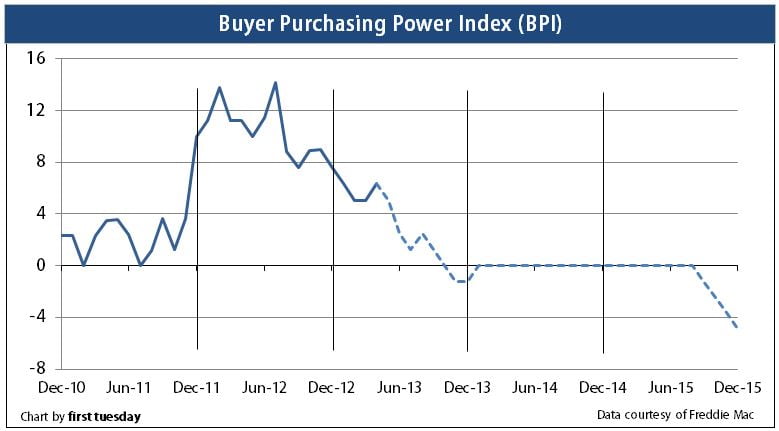The buyer purchasing power index (BPI) increased to 6.36 in April 2013. This score is up from 5.05 in March. However, BPI is down from the high scores experienced throughout 2012.
The April 2013 BPI represents a 6.36% year-over-year increase in mortgage funds available to today’s buyers. However, the recent rise in home prices has effectively neutralized buyers’ increased purchasing power. For sellers, conditions remain positive for some upward home price movement until later this year when pricing will likely trend flat.
first tuesday forecasts the BPI will drop to zero by mid-2013 and remain there through 2014. The BPI will go negative in 2015 when long-term rates rise due to a more dynamic economy. Sellers will then experience downward pressure on prices, as buyers are able to borrow less with the same income.
| April 2013 | March 2013 | April 2012 | |
| Buyer purchasing power index (BPI) | 6.36 | 5.05 | 11.23 |
The BPI is calculated using the average 30-year fixed rate mortgage (FRM) rate from Freddie Mac (Western region) and the median income in California.
A positive index number means buyers can borrow more money this year than one year earlier.
A negative index figure translates to a reduced amount of mortgage funds available.
An index of zero means there was no year-over-year change in the amount a buyer can borrow. At a BPI of zero, homebuyers cannot purchase at higher prices than one year before unless they resort to adjustable rate mortgages (ARMs).
As BPI rises, a buyer can borrow more purchase-assist funds. In turn, they can acquire a higher priced home.
—
first tuesday journal online is a real estate news source. It provides analyses and forecasts for the California real estate market, and has done so since 1978.















What is the assumption used by the writer to ‘declare’ with confidence that the interest rate will rise in 2015, leading to decrease in the borrowing power of the ‘Buyer’?
Aren’t there any other factors to consider the downward pressure on Real Estate,e.g.,cost of replacement;labor;land,etc.,?